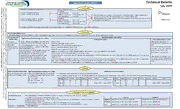
Technical Bulletin: Groundwater Road Map PDF
Preview Technical Bulletin: Groundwater Road Map
Technical Bulletin Groundwater Quality Analysis July 2009 1‐Vulnerability Vulnerability Assessment and Delineation (R:37): one or more of the methods mentioned below: (R:38{1,3}) 1‐Intrinsic susceptibility index (ISI). High vulnerability: Score < 30 2‐Aquifer vulnerability index (AVI). Medium vulnerability: Score ≥30 and < 80 Vulnerability areas can change from low to medium or high (R:39)and from medium to high (R:40)if Low vulnerability: Score ≥80 transport pathways exist with the following factors that shall be considered (R:41): 3‐Surface to aquifer advection time (SAAT). (R:38{2,3}) hydro‐geological conditions; type and design of any transport pathways; cumulative transport pathways; High vulnerability: results < 5yr and/or any other assumptions. 4‐Surface to well advection time (SWAT). Medium vulnerability: results ≥5yr and < 25yr Low vulnerability: results ≥25yr 5‐Another method that in the opinion of the director is equivalent or better than the methods mentioned above with applicability of (R38{1,2,3}). 2‐Delineation Recommended Methods (R:42): 1‐3D‐GW flow model; 2‐2D analytical model; 3‐Uniform flow method; 4‐Fixed radius method; or 5‐Other method that is better or equivalent than methods (1 ‐4) in the opinion of the director. Highly Vulnerable Wellhead Protection Areas (WHPA) Significant Groundwater Recharge Areas (SGRA) Aquifers (HVA) Drinking Water System I Drinking Water System II and III It is an area If an area recharges to an aquifer at a rate of ≥15% of Areas are (R:47): If the system is registered in the according to Rule the whole area related GW recharge rate (R:44{1}); or WHPA‐A(cid:198)Radius=100m @centre of well SDWA, the areas to be delineated are 38 and the If the annual recharge of an area is ≥55% of the WHPA‐B(cid:198)Time of Travel (ToT) ≤2yr (excluding WHPA‐A) (R:51): subsurface zone volume of (Precipitation –Evaporation) of the whole WHPA‐A(cid:198)R=100m @centre of well WHPA‐C(cid:198)Time of Travel (ToT) > 2yr but ≤5yr beneath that area GW recharge area (R:44{2}). WHPA‐B(cid:198)ToT≤2yr (excl. WHPA‐A) (R:43). WHPA‐D(cid:198)Time of Travel (ToT) > 5yr but ≤25yr And(R:45): where there is a hydrological connection to WHPA‐C(cid:198)ToT> 2yr but ≤5yr WHPA‐E(cid:198)same as IPZ‐2 (1‐at the interaction point between GW and SW; or 2‐at the point that SW connects to GW) surface water body or aquifer that is a source of WHPA‐D(cid:198)ToT> 5yr but ≤25yr Drinking Water for a Drinking Water system. WHPA‐F(cid:198)same as IPZ‐3 (at the point where the SW affects the GW) Considerations(R:46): SGRAs are delineated using Or (R:48): If delineation is done before April 30th2005 then the following applies: All WHPAs are delineated as inRule 47 except the WHPA‐C1 which is based on ToT> 2yr but ≤10yr. model(s) developed for the purpose of a water Additional Areas: If the system is not registered (R:52): then an area of WHPA is delineated as budget(s), Part (III), such as topography, surface For WHPA‐E: (R:49{a,b})only added for GUDI wells (Groundwater wells Under the Direct Influence of Surface Water) as per the Safe Drinking Water Act and if the well receives raw a combination of WHPA‐A and WHPA‐ geology, and effects of interacting the GW and SW. water from an area that is influenced by the interaction betweenGW and SW and reduces the ToTto the well (R:49{c}). B only. For WHPA‐F (R:50): only for areas that contain WHPA‐E; issue contributing area to the drinking water; issue contributing areas outside the WHPA‐A,B,C,C1,D,E. 3‐Scoring Highly Vulnerable Aquifers (HVA) Significant Groundwater Recharge Areas (SGRA) Wellhead Protection Areas (WHPA) If the area does not overlap with a SGRA areas shall be divided into sub‐areas of GW An area of WHPA shall be divided into sub‐areas (R:82)and scored as follows: WHPA, the score shall be 6 (R:79). vulnerability according to Rule 38 (R:80)and can If the vulnerability is based on Rule 37 (1 or 2) and Rule 84 and Rule 85, then apply table 2a. If the vulnerability is based onRule 37 (3 or 4) and Rule 84 and Rule 85, then apply table (2b). be scored as (R:81): High Vulnerability (cid:198)6 Table 2a WHPA‐A WHPA‐B WHPA‐C WHPA‐C1 WHPA‐D WHPA‐E WHPA‐F Table 2b WHPA‐A WHPA‐B WHPA‐C WHPA‐C1 WHPA‐D WHPA‐E WHPA‐F Medium Vulnerability (cid:198)4 High 10 10 8 8 6 High 10 10 8 8 6 Low Vulnerability (cid:198)2 Medium 10 8 6 6 4 Same as IPZ‐2 Same as IPZ‐3 Medium 10 8 6 6 4 Same as IPZ‐2 Same as IPZ‐3 Low 10 6 4 4 2 Low 10 6 2 2 2 4‐Overview of Threat Identification Drinking Water Threat: Activities (R:118‐125)or conditions (R:126)that could affect the quality of drinking water. New threats can be added by Source Protection Committee with approval of the director. Activities Conditions Approaches: Threats Approach (R:127 to 137), i.e. activities in the list of drinking water threats, new drinking water threats/circumstances can be added Significant Hazard rating > 4 + Risk Score ≥80 (R:128) Hazard rating =10 + Risk Score ≥80 (R:139,140) by SPC with approval of the director. Moderate Hazard rating > 4 + Risk Score ≥60 to < 80 (R:132) Risk Score ≥60 to < 80 (R:139,142) Event Based Approach (R:130), i.e. activities where models show activities can cause an issue at a well. Issues Approach (R:131), i.e. activities that are located in an issue contributing areaand can contribute to that issue. Low Hazard rating > 4 + Risk Score ≥40 to < 60 (R:136) Risk Score ≥40 to < 60 (R:139,143) Risk score = Hazard rating * Vulnerability score
